
Source: Fix.com Blog
Stress in America
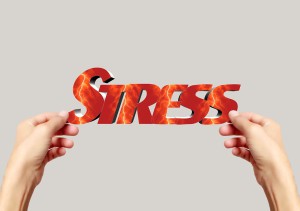 Since 2007, the American Psychological Association (APA) has commissioned an annual nationwide survey as part of its Mind/Body Health campaign to examine the state of stress across the country and understand its impact. The survey is called Stress in America, and is considered our best stress barometer. The Stress in America™ survey measures attitudes and perceptions of stress among the general public and identifies leading sources of stress, common behaviors used to manage stress and the impact of stress on our lives. The results of the survey draw attention to the serious physical and emotional implications of stress and the inextricable link between the mind and body.
Since 2007, the American Psychological Association (APA) has commissioned an annual nationwide survey as part of its Mind/Body Health campaign to examine the state of stress across the country and understand its impact. The survey is called Stress in America, and is considered our best stress barometer. The Stress in America™ survey measures attitudes and perceptions of stress among the general public and identifies leading sources of stress, common behaviors used to manage stress and the impact of stress on our lives. The results of the survey draw attention to the serious physical and emotional implications of stress and the inextricable link between the mind and body.
In the book, The End of Stress: Four Steps to Rewire Your Brain, the author, Don Joseph Goewey writes, “In its most recent survey, the APA concluded that the data portrays a picture of high stress and ineffective coping mechanisms that appear to be ingrained in our culture, perpetuating unhealthy lifestyles and behaviors for future generations.” The goal of Goewey’s book is to break that chain by providing a clear path for resolving this crisis once and for all. In his research, Goewey says the first thing he learned was that there are two major brain systems that determine the degree to which you will actualize the brain power needed to succeed at life.
In this blog post, I’ll include the names of both these brain systems, while also giving you a much better understanding of how they function within the body. To help you better understand, the following paragraphs use precise language taken from the introductory paragraphs of Goewey’s book, The End of Stress: Four Steps to Rewire Your Brain.
The first system is called the higher brain. Its proper name is the prefrontal cortex, and much of what we define as human intelligence is generated in this part of the brain. Goewey says, the higher brain invented art, music, science, agriculture, engineering, commerce, government, and lots of other things. It is also where the brain’s chief executive has its office, performing the executive functions that produce the plans and strategies that achieve goals. Executive functions draw on all the higher-order cognitive skills that question perceptions, analyze facts, adapt to change, and integrate information– delineating and prioritizing the logistics that move plans forward. Executive functions also take the creative insight generated by the right brain and translate it into practical innovation.
The second system is the lower or primitive brain, which actually inhibits your potential for success. The lower brain is where the stress response system resides, and the stress response system, as well as much of the primitive brain, is governed by the brain’s fear center, the amygdala. The amygdala plays a substantial role in negative mental states such as distress, aggression, anxiety, depression, and all those emotions that fall under the heading of fight, flight or freeze.
The amygdala cannot distinguish a real and present danger from something you misperceive as a threat. Its intelligence is reactive, not analytic. It invites the higher brain to weigh in on a potentially threatening situation only if its a new experience. Goewey says, when your nervous system senses any kind of threat, a signal is sent to the thalamus (a kind of neurological switchboard) and then relayed to the amygdala to activate an aggressive or defensive reaction. The sequence from threat to fear response happens in a knee-jerk fashion at lightning speed and occurs outside of conscious awareness. The amygdala is a survival system, which means it doesn’t take chances. Its motto is “He who hesitates is dead.” Thus, it’s programmed to shoot first and ask questions later. When there is a real and present danger, such as a coiled rattlesnake on the path, the speed of the amygdala works to increase the odds of living another day.
Stand-Up Paddle Boarding (SUP): A Mind and Body Workout
So what is this SUP craze all about?
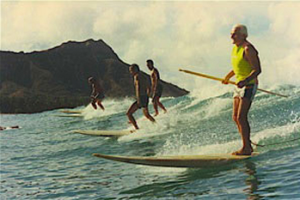 Despite it’s recent meteoric rise to become America’s fastest-growing water sport, it’s not all that new.
Despite it’s recent meteoric rise to become America’s fastest-growing water sport, it’s not all that new.
Historians point to Duke Kahanamoku as the genesis, as shown in this 1939 video on YouTube. It continued to evolve through the 1960s when the “Beach Boys of Waikiki” would stand up on their longboards to photograph tourists who were learning to surf. Then in the 1990’s with surf legend Laird Hamilton standing up (pun intended), Stand-Up Paddleboarding was officially the new hotness. Since, it has continued to grow through California and now has penetrated the U.S. east coast shoreline, rivers, bays.
There are various types of stand up paddling, including flat water paddling for outdoor recreation, fitness, or sightseeing, racing on lakes, large rivers and canals, surfing on ocean waves, paddling in river rapids (whitewater SUP), and even SUP Yoga. Unlike traditional surfing where the rider is sitting until a wave comes, stand up paddle boarders maintain an upright stance on their boards and use a paddle to propel themselves through the water. Turns out, between the necessary balance and paddling, it’s a killer core workout and a surprisingly meditative experience.
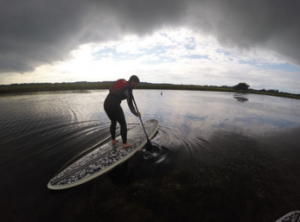 Prepare
Prepare
If you’re nervous about your balance, strengthening your core and back muscles through planks, side planks, and even dolphin pose to target your shoulders, arms, and upper back, before getting in the water will help you to be more secure on the board. Another great gym workout to practice your SUP muscles is standing on the bosu ball with the rounded part towards the floor. It may be a little scary at first as your central nervous system wakes up to activate the necessary muscles to allow you to balance. As this happens, my clients and I will often experience involuntary shifting side to side. Though it will feel strange as your body finds its equilibrium, it’s no reason to hop off. After a little bit of practice, you will be able to do air squats atop the bosu ball, and once those are too easy, pistol squats.
With all that being said, don’t be afraid to give SUP a shot. One of the reasons it is so popular is its accessibility. Even if you have been inactive lately, you’ll find that your body will adapt quickly.
Stand Up
Once you are ready, mount your board and stand up straight with your feet in a wide, evenly spaced stance. Your weight should be relatively centered on the board as youl maintain an upright position with your back straight. Then, maintaining this posture, you will paddle a few strokes on one side to then switch to the other if you feel you are turning. That’s it!
It doesn’t sound like much, and to watch someone do it, it doesn’t look like much. But the secret is in what is going on within your body. The work behind SUP is all isometric and resistance. Your legs and your core muscles are working at all times to keep you balanced on your board. At first you will feel it! Your body is working many large and small muscles to hold you upright and stabilize you, as you and your board move over the water. These movements are not favoring left or right, front or back, but working your whole body evenly.
Like any other outdoor activity stand up paddleboarding deserves respect and attention, as it challenges you both physically and mentally. The more you delve into this rich world and the more you become aware of its intricacies, and the more fulfilling it will become for you and your friends.
Explore
So much so, it has provided the opportunity for many enthusiasts to launch new businesses to make the sport more accessible. I speak from experience, as this Spring, I will be launching Balance Paddleboarding in Alexandria to experience the Potomac River and her tributaries like never before.
If Alexandria isn’t convenient, Travel channel made a slide show on the best places to SUP. A few places of note are Santa Barbara Harbor’s calm waters, ideal for learning the sport, or the clear waters along Abacos in the Bahamas. In Costa Rica, SUP has become an increasingly popular alternative to surfing, as paddle boarders can enjoy the marine life along with continually calm, warm waters. Not featured by Travel Channel, but one of my personal favorites is Lake Austin in Austin, TX.
Read more: How To Paddle Board Out In The Ocean
Healthy Meditation
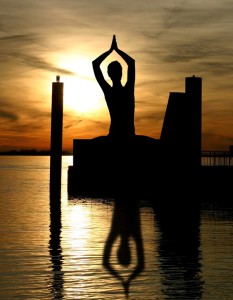 Today, the pace of modern life has significantly increased the chances of a person feeling stressed out during a given day. People who juggle multiple responsibilities including, issues related to work, home life, caregiving, relationships, etc., are prone to experiencing some level of stress. When this happens, your body responds as though you are in danger. It makes hormones that speed up your heart, make you breathe faster, and give you a burst of energy. According to WebMD, this is called the fight-or-flight stress response and it is a normal psychological and physical reaction to keeping up with today’s ever-increasing demands of life.
Today, the pace of modern life has significantly increased the chances of a person feeling stressed out during a given day. People who juggle multiple responsibilities including, issues related to work, home life, caregiving, relationships, etc., are prone to experiencing some level of stress. When this happens, your body responds as though you are in danger. It makes hormones that speed up your heart, make you breathe faster, and give you a burst of energy. According to WebMD, this is called the fight-or-flight stress response and it is a normal psychological and physical reaction to keeping up with today’s ever-increasing demands of life.
However, if stress happens too often or lasts too long, it can have bad effects. According to WebMD, it can be linked to headaches, an upset stomach, back pain, and trouble sleeping. Additionally, it can weaken your immune system, making it harder to fight off disease. Learning to identify problems and implement solutions is key. There are many ways to engage in stress management techniques. In this blog post, I’ll talk about one of the oldest ways and explain the significant health and cognitive advantages of engaging in such mindful activity.
Meditation dates back to ancient times and was spread to Western societies thousands years after it was adopted in the East. Throughout history, people have meditated to help deepen their understanding of the sacred and mystical forces of life, according to information on the Mayo Clinic’s website. It finally started to gain popularity in the West in the mid-20th century. In the 1960s and 1970s, professors and researchers began testing the effects of meditation and learned about its multitude of benefits. Robert Puff, Ph.D., summarizes some of this widely publicized research on meditation in a blog post published on Psychology Today. He explains, “In the late 1960’s, Dr. Herbert Benson of Harvard Medical School conducted some scientific studies to test the health benefits of meditation…He determined that meditation could be used successfully in treating physiological problems, such as high blood pressure, heart disease and migraine headaches, as well as autoimmune diseases such as diabetes and arthritis.” Repeated studies have demonstrated this ability of meditation to rewire the way your brain responds to stress.
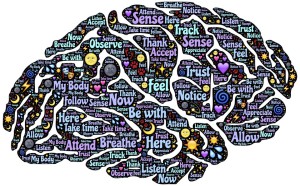 Contemporary researchers are now exploring whether consistent meditation practice yields long-term benefits, and noting positive effects on brain and immune function among meditators. Today, classes in meditation and mindfulness are even being incorporated within companies of different industries, especially in Silicon Valley. Yet it is worth repeating that the purpose of meditation is not to achieve benefits. To put it as an Eastern philosopher might say, the goal of meditation is no goal. It is simply to be present. In Buddhist philosophy, the ultimate benefit of meditation is liberation of the mind from attachment to things it cannot control, such as external circumstances or strong internal emotions. The liberated, or “enlightened,” practitioner no longer needlessly follows desires or clings to experiences, but instead maintains a calmness of mind and sense of inner balance. – Source
Contemporary researchers are now exploring whether consistent meditation practice yields long-term benefits, and noting positive effects on brain and immune function among meditators. Today, classes in meditation and mindfulness are even being incorporated within companies of different industries, especially in Silicon Valley. Yet it is worth repeating that the purpose of meditation is not to achieve benefits. To put it as an Eastern philosopher might say, the goal of meditation is no goal. It is simply to be present. In Buddhist philosophy, the ultimate benefit of meditation is liberation of the mind from attachment to things it cannot control, such as external circumstances or strong internal emotions. The liberated, or “enlightened,” practitioner no longer needlessly follows desires or clings to experiences, but instead maintains a calmness of mind and sense of inner balance. – Source
Furthermore, Poet and Zen Priest, Tai Sheridan says, sitting quietly can teach many ways to accept life, meet pain, age gracefully, and die without regret. He reminds us something very important in regards to meditation, especially among beginners… “You do not have to be Buddhist. You can be of any faith, religion, race, nationality, gender, relationship status, or capacity. Just sit quietly, connect with your breath, and pay attention to what happens.”
Health Benefits of Snorkeling
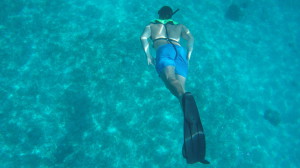 This summer, I was fortunate enough to be invited to spend a week in the Bahamas to participate in a week-long Yoga Retreat with my amazing girlfriend. As great as the Yoga was, we weren’t going to end the trip without sneaking away to do some snorkeling.
This summer, I was fortunate enough to be invited to spend a week in the Bahamas to participate in a week-long Yoga Retreat with my amazing girlfriend. As great as the Yoga was, we weren’t going to end the trip without sneaking away to do some snorkeling.
For those of you who haven’t snorkeled before, it is an incredible experience that I highly recommend. All you need are basic swimming skills and the ability to breathe through a snorkel. As I explored the reefs, it occurred to me how similar the controlled breathing techniques required of snorkelers are to many meditative breathing methods used to relax, like Pranayama yoga. Breathing through a tube involves resistance and requires a lot more exertion than free breathing, especially after diving when you purge the water from your snorkel by explosively exhaling, much like a Whale blowing water out of its blowhole.
 People of all ages and sizes can quickly and easily learn to snorkel. It doesn’t require undergoing extensive training or lugging around bulky and heavy equipment.
People of all ages and sizes can quickly and easily learn to snorkel. It doesn’t require undergoing extensive training or lugging around bulky and heavy equipment.
Snorkeling is a recreational pastime that can passively get you closer to your fitness goals. It can also help relieve stress and anxiety. Mental health expert Cristina Desa says, “Snorkeling can increase self-confidence through the release of endorphins.”
If you haven’t snorkeled before and are still unsure as to whether you have what it takes, most certifying agencies require that you meet a standard similar to the following one before they can certify you. If you have a pool available to you, test yourself and see where you are in compared to the standards.
- Swim 200 yards (approximately four lengths of an Olympic-size pool).
- Submerge your head and open your eyes under water.
- Stay afloat for 10 minutes without snorkeling gear or outside assistance.
- Swim underwater for 15 yards without gear and without pushing off the side of the pool.
Snorkeling isn’t just an excellent form of exercise; it is also the easiest way to witness the beauty of underwater life. The Caribbean reefs are particularly special, made more so by the rate at which they are disappearing. Despite being vital to the region’s economy and supporting the more than 43 million people, they’re under siege by increased temperatures and ocean acidity from carbon dioxide. According to an article published by the Guardian, most Caribbean coral reefs will disappear within the next 20 years.
Here’s a short clip from when we snorkeling. It’s not from the reef, but rather from just snorkeling along the beach by the retreat. We spotted a fish shadowing a sting ray along the bottom, swimming directly on top of it. If you’re a marine biologist or otherwise just know why, I would love to hear an explanation.
Mental Strength in Physical Fitness
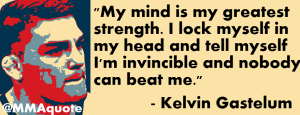
Whether you are training for the next triathlon, a new 1 rep max on bench press, or just trying to cut a few pounds, the key to achieving long lasting success is mental toughness. Some find a momentary boost in energy, fueled by excitement, is enough to begin a new regimen, but how long does this really last?
Soon after the initial high fades, when you’re forced to wake up early the first time or sacrifice a night out with friends, you find yourself back where you started.
Here, mental toughness shines, and we are given the opportunity to embrace the grind. Rarely is there a concrete checkpoint or destination. Rather, it’s the process, a mindset, and a belief in self that continuously re-develops and reinforces the power to keep going.
Imagine yourself struggling to accept defeat in a race for which you’ve put in tiresome hours of workouts and training.
Does losing make you feel worse? Or does it change your perspective and refocus your efforts for the future. Herein lies the difference between mental fitness and the untrained, weak mindset.
Mental fitness is so crucial to fostering physical fitness. Just as a healthy pulse returns to its resting rate after some time, a positive mindset stays positive when dealing with negativity or defeat. It’s what allows one to bounce back, stand up, and keep fighting.
The resilience derived from being mentally fit says more about the one’s perspective than anything else. It’s what enables us to visualize the end goal when no one else can. Sure, it’s unavoidable that distractions will arise that pull us away from our goals, but mental fitness, built upon resilience, commitment and focus, keeps us on track. It keeps us focused on the task at hand, and filters out the negative and irrelevant thoughts that push us farther away from our goals.
Carrie Cheadle, Mental Skills Coach and author of On Top of Your Game – Mental Skills To Maximize Your Athletic Performance says “When you are mentally tough it means you can delay immediate gratification and make decisions in the moment that are in service to your ultimate goal.” Similarly, focus keeps us aware of the things we can control, and lets us be absolved of all that we cannot control. Through this freedom we can continue to hone our mental fitness.